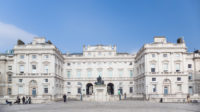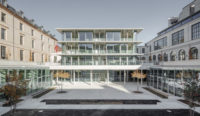A base-isolated makeover for Pasadena's historic City Hall

Pasadena City Hall
The seismic update and architectural renovation of Pasadena’s City Hall included the base isolation of the dome, as well as the structural buttressing of the courtyard staircases.
Photo © Victor Muschetto

Pasadena City Hall
The seismic update and architectural renovation of Pasadena’s City Hall included the base isolation of the dome, as well as the structural buttressing of the courtyard staircases.
Photo © Victor Muschetto

Pasadena City Hall
The seismic update and architectural renovation of Pasadena’s City Hall included the base isolation of the dome, as well as the structural buttressing of the courtyard staircases.
Photo © Victor Muschetto

Pasadena City Hall
The base isolator level supports a new basement slab. With a transfer beam, each isolator can support two structural columns.
Photo © Victor Muschetto

Pasadena City Hall
The base isolator level supports a new basement slab. With a transfer beam, each isolator can support two structural columns.
Photo © Victor Muschetto




Post a comment to this article
Report Abusive Comment